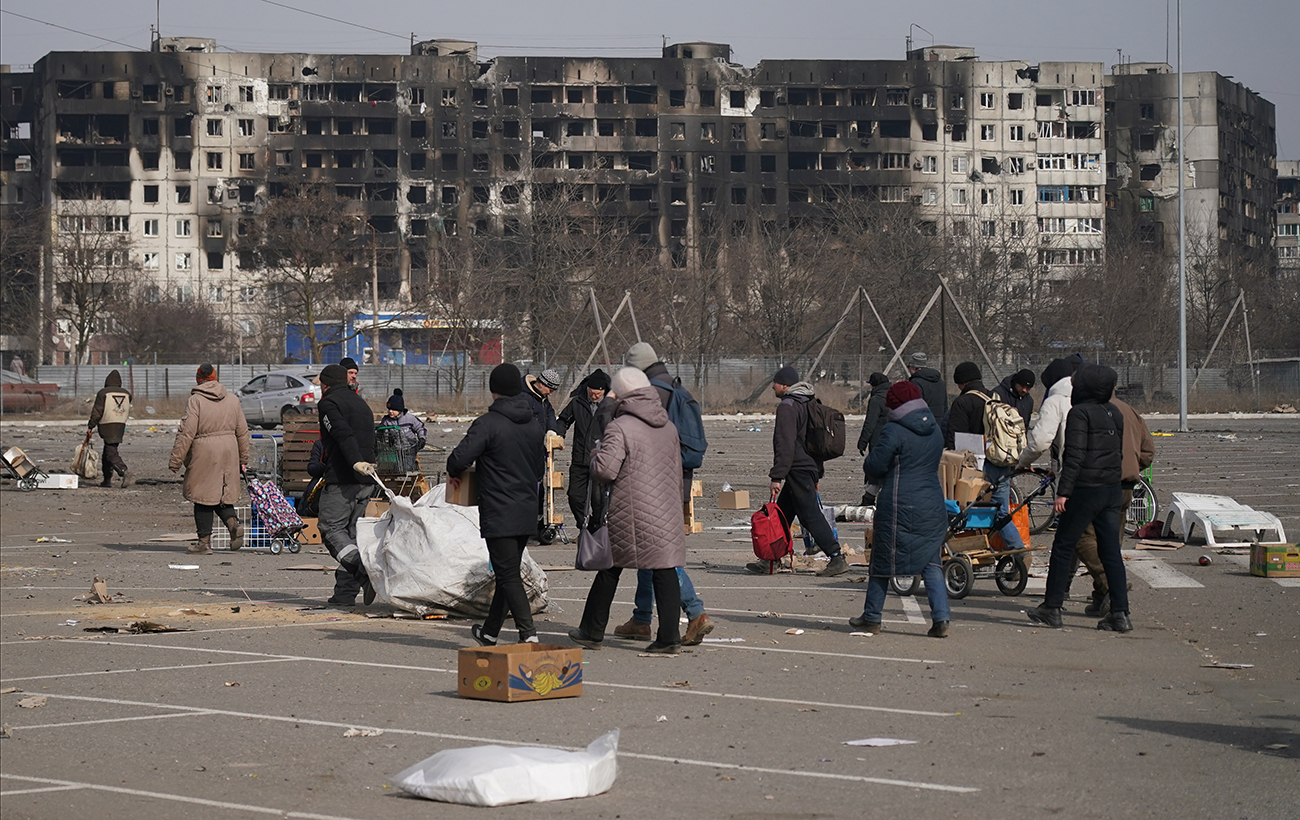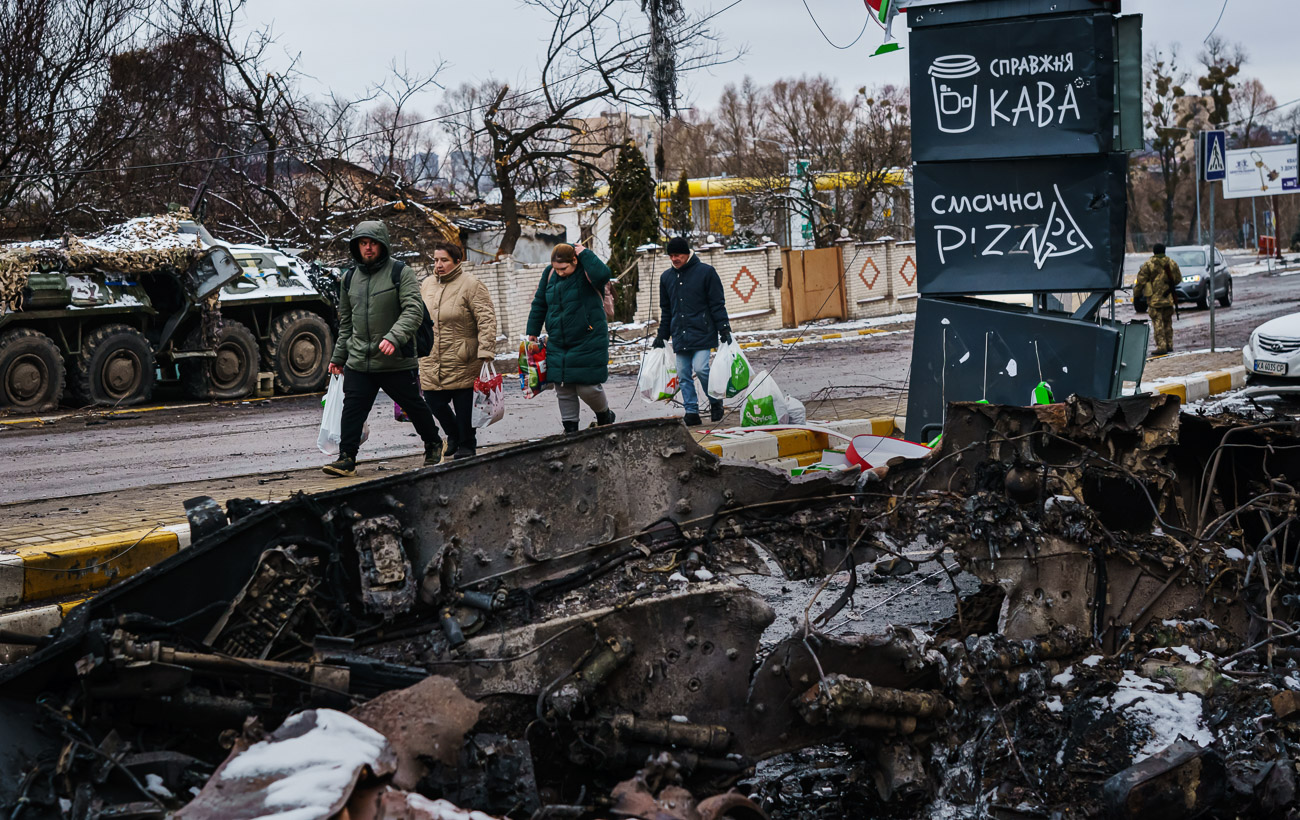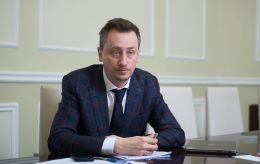'Russian world' standards. How Russia breaks Ukrainians on occupied land and distorts reality
 Russian military in Mariupol (Getty Images)
Russian military in Mariupol (Getty Images)
A part of Ukraine has been under Russian occupation for nearly 10 years, with some cities in southern Ukraine for almost two. Read below what methods Russian occupiers use to assert control, how effective they are, and what the Kremlin seeks to achieve.
The story includes comments from Ukrainian historian Roman Kabachiy, producer of 1+1 media and host of Real History channel Akim Galimov, former mayor of Melitopol and head of the Zaporizhzhia Regional Military Administration Ivan Fedorov, as well as information from open sources.
Starting a full-scale invasion of Ukraine, the Russian authorities have repeatedly stated that occupation and further annexation of territories to the Russian Federation are not part of the Kremlin's plans. "We want Ukrainians to decide for themselves how they will live on. We want them to have freedom of choice," cynically stated Russian Foreign Minister Sergey Lavrov back in April 2022.
In reality, however, Russian troops and special services, upon capturing Ukrainian cities and villages, almost immediately sought to establish themselves as the new "legitimate" government. In Kherson, the occupiers declared that they were "here forever". Similar narratives are used in other occupied parts of Ukraine. Ultimately, Ukrainian territories captured by the Russian army have even been included in the Russian Constitution, thereby completely undermining Moscow's thesis that occupation is not the Kremlin's goal.
However, simple physical occupation is far from the only instrument used by the Russians. Upon seizing a Ukrainian city or town, Russian special services employ a whole range of methods, from violence to "forced affection." These methods have been tested for decades - the Kremlin uses them basically wherever it can reach.
Destroy and conquer
Russians often don't have a plan to destroy the hypothetical city they want to occupy. But they also don't try to keep it intact, trying to capture it without losses. The Kremlin operates by a simple rule - it's impossible to enter foreign territory without using force, so force must be used.
Similar examples the world has already seen in Grozny, which the Russians almost destroyed before capturing. To subdue and neutralize Syrian opposition forces, Russian aviation razed Aleppo to the ground. This city will later be compared to the Ukrainian Mariupol, which was almost entirely destroyed when the Russian army occupied it.
This deliberately brutal method of warfare is one way of intimidating and subjugating the local population. It also shows that the Kremlin has no intention to adhere to any international rules and conventions, intimidating with its arrogance and impunity.
_1_1.jpg) Russian military in Mariupol (Getty Images)
Russian military in Mariupol (Getty Images)
In the occupied city, Russians are setting up checkpoints, entering administrative buildings if intact, and hoisting their flags. The cleansing phase begins. Any resistance is strongest at the outset while there are still resources and strength, so some Russians immediately start patrolling the city, while others take control of law enforcement agencies.
In Kherson, partisans were systematically hunted down. Local Oleksiy Syvak was captured by the occupiers six months after the city was seized. Everything done to him - from rough detention and searches before his release - was aimed at breaking his will and desire to resist.
"In the evening, the prison chief came to me and asked, 'Were you speaking out at the referendum?' They said they don't fight with civilians," Syvak recounted in an interview with RBC-Ukraine.
While "working" with captives, Russians often try to pit them against local collaborators. Thus, the occupiers show that locals are supposedly "on their side," and resisting is useless. This imperial method of subjugating some locals with others has been and is being applied wherever Russians act as aggressors. In the Republic of Sakha (Yakutia), for example, Yakuts are deliberately brought into regional leadership positions to comply with Kremlin demands.
"Thus, we have our own mankurts - slaves of this empire who oppress their own people. All empires do this. Divide and conquer," said Vladislav Ammosov, a resident of Yakutia who is now fighting in the ranks of the Ukrainian Armed Forces, in an interview with RBC-Ukraine.
Violence in the occupation is deliberately made conspicuous - the shooting of protesters in Kherson, storing bodies of the deceased in a supermarket in Mariupol, mass burials in Izium, torture, and rape in Bucha. Russians kill in a way that others can see, thus they intimidate and depopulate. When cruelty is shown before your eyes on such scales and repeatedly, even iron will breaks down eventually.
'Russia is here forever'
In de-occupied Kherson in the first days after liberation, one could see billboards depicting people smiling unnaturally with phrases like "Kherson is a Russian city," "Russian citizenship - social stability and security," "Your own apartment, free healthcare." All these statements and promises are one of the stages of building legitimate authority based on occupation.
 Billboard in de-occupied Kherson (Vitalii Nosach/RBC-Ukraine)
Billboard in de-occupied Kherson (Vitalii Nosach/RBC-Ukraine)
Legitimization is any attempt by occupiers to tie the local captured population to Russia at the bureaucratic level. Passport issuance, Russian currency, housing registration, opening of Russian banks, even referendums - all of these are related to legitimization. By the way, any voting in the occupied territories is not about gathering votes but showing the residents that a new authority has come to the city and is already conducting bureaucratic procedures, notes Ivan Fedorov, former mayor of temporarily occupied Melitopol and chairman of the Zaporizhzhia Regional Military Administration.
"Even when they force people to vote in these fake elections, it's not so much about the result as about the people feeling that elections are possible, and therefore, their authority is legitimate. When they knock on the door, the person opens it, and they ask, 'Will you participate in the elections?' The person subconsciously understands that such a question is possible," says Fedorov in a comment to RBC-Ukraine.
Russian citizenship becomes the primary document in the occupation, without which the range of possibilities gradually narrows practically to zero. Buying a ticket, going to the hospital, and submitting documents anywhere becomes impossible without a Russian passport. Forced passportization is another way to show that Russia is here forever. The method, as always, is not new. Russia distributed its passports in the occupied Transnistria, and in 2014, nearly half of the population of the "republic" obtained them. In the occupied parts of Georgia, mass issuance of Russian passports began in 2022. A year before that, Russian President Vladimir Putin signed an agreement with South Ossetia on simplifying the acquisition of Russian citizenship.
Between 2019 and 2022, 720,000 residents of the occupied Donbas received Russian passports. The presence of Russian citizens in the occupied territories, according to the Kremlin's opinion, gives it the right to justify any of its actions. Therefore, during the invasion, propagandists claimed that their army was not only coming to liberate Russian-speaking citizens but also citizens of Russia.
 Evacuation from Mariupol (Getty Images)
Evacuation from Mariupol (Getty Images)
The housing issue also plays a significant role in legitimizing the occupation authority. For example, in the occupied Mariupol, Russians promised residents that they would rebuild their destroyed homes and provide them with "compensatory apartments." The occupation authority brought Russian contractors to the city, who even installed windows in some buildings and erected several concrete blocks resembling barracks. The Russians did not fulfill their promise of "compensatory apartments," and now locals criticize them. But what is more important is the fact of dialogue between the occupiers and the residents of Mariupol. In two years of occupation, it became possible, as the locals addressed the Russians as a very ineffective and constantly deceptive authority. The same happened in Donbas, where Donetsk residents turned to local collaborator Denis Pushilin for their communal problems.
Dialogue holds immense significance in the case of occupation. While residents of captured cities, without shelter, water, or electricity, are forced to listen to the promises of occupiers, the occupiers themselves can portray these "dialogues" as the locals reaching out to the authorities, which looks like their recognition in the Ukrainian city.
The Russian ruble is another way to tie the captured region and make it dependent on Russia. Any settlement that starts circulating foreign currency is somehow recorded in documents, bank statements, and other bureaucratic elements. Russians attempted to introduce the ruble in Kherson, but locals persistently continued to use hryvnias. Since the occupation lasted for 8 months, the Russian "authority" never managed to tie Kherson to its currency. Instead, the ruble was introduced in the occupied Donbas as early as 2015. In Melitopol, banks started operating where an account could only be opened in rubles, and in Berdyansk, fines were imposed for using hryvnias in the amount of 5 thousand rubles. Despite these measures, there was a black market in the city where residents exchanged rubles for hryvnias and sent them to the Ukrainian Armed Forces.
Bureaucratic legitimization is one of the most powerful methods of tying the captured territory. In the Donbas, after almost 10 years of occupation, entire generations have grown up who use the ruble and carry Russian Federation or "republic" passports. The Kremlin is betting that sooner or later the residents of the captured cities will accept their presence, every day seeing money saying "Central Bank of Russia."
Information blockade
By intimidating people and tying them to their bureaucratic systems, one can proceed to "forcing love." One of the main methods of coercion is propaganda. For it to work effectively, it is necessary to ensure that, besides propaganda, a person in the captured city hears nothing else.
In occupied Kherson, residents climbed onto rooftops to catch a signal and read the news. Initially, the Russians simply jammed the communication, leaving people in an information vacuum, and then conducted their own. In the early 2000s, during the Chechen war, occupiers simply neutralized journalists who reported on the atrocities of the occupiers. Today's era of digital technology requires Russians to be more cunning, so propaganda has become more sophisticated.
"Russians need to eliminate dissent. These measures include an information vacuum, restrictions on internet access, television, and even through VPNs. When it was possible with VPNs, utility workers were forced to sign written agreements that they would not use VPNs," explains Fedorov.
 Bucha after the invasion of the Russian military (Getty Images)
Bucha after the invasion of the Russian military (Getty Images)
Gaining any outside information in an occupation is difficult. The vacuum created is overly filled with Russian propaganda. Federal channels dominate television, and newspapers tout the successes of the Russian army, claiming to liberate Ukraine from Nazis. Russian military personnel can approach anyone on the street at any moment and inspect their phones to check which social media channels they are subscribed to. Like with rubles or passports, Russians are ready to play the long game, and Russian propaganda, as one of the Kremlin's most powerful tools, can facilitate.
"Living in an informational vacuum, deprived of alternative information, and enduring mockery, two years is a considerable term. Look at how much we've changed in two years. We have access to absolutely any information. If there's just a vacuum there, devoid of alternative thought, whether you like it or not, you'll find yourself agreeing with these narratives that the enemy tries to impose on you," Fedorov adds.
Russia employs the same methods of information warfare everywhere it occupies territories. Russian TV exclusively operates in all captured cities and villages. Local broadcasts are either minimized or shut down. The same goes for internet media.
You're either Russian or you're Russianized
The most potent tool of Russification on occupied territories is ethnic cleansing. Propaganda, legitimization, and repression work effectively, but even after decades, underground partisans and insurgent movements can still periodically shake up the scared and weary population. To render their actions meaningless, it's necessary to eliminate or replace the population's national attachment to their country. To achieve that, one has to eradicate or substitute that nationality.
Measures are employed with all layers of the population. The first thing the occupiers do is alter the educational curriculum in the region they have occupied. Educators are either coerced into cooperation or replaced with their own. Books are burned, while museums are looted. Anything bearing historical or cultural significance, any mention of nor being Russia, is subject to destruction, notes historian Roman Kabachiy.
"My village in the Kherson region is still under occupation. As my fellow villagers told me, the Russians took Ukrainian-language books from the school library into the field and burned them. Then they pressured the priest of the Orthodox Church of Ukraine to either switch to the Moscow Patriarchate or hand over the keys. They forced him to hand over the keys to the church," Kabachiy recounted in a comment to RBC-Ukraine.
 Russian military in Mariupol (Getty Images)
Russian military in Mariupol (Getty Images)
The Russian rhetoric of convincing differs depending on the legend under which they entered one country or another. For example, Ukrainians in the occupation are trying to be convinced that they are actually Russians, just "misguided." In the Donetsk school curriculum, children are taught about the valor of fighters of the "republics" and "Ukrainian Nazis" in "civic education" classes. In history classes, educators explain to students that Russia is the heart of the world, that Vladimir Lenin invented Ukraine, and that Russia, Belarus, and Ukraine are a "triple union." In other words, by developing a "methodology" for capturing Ukrainian cities, the Kremlin decided to bet on the old legend of "brotherly peoples" with a shared history.
This same legend would not go for Georgians or Chechens, as convincing them that they are "misguided Russians" would be quite problematic. Therefore, in Georgia, Russians operated with the "divide and conquer" principle playing on the ethnic conflict between Abkhazians and Georgians. In Chechnya, besides using brute force, they relied on local Russians who appeared there as a result of Stalin's forcible deportation of Chechens from Grozny back in the era of Joseph Stalin.
By the way, Russians widely employ this method – orchestrating mass resettlements and displacing ethnic populations. Back in the days of the Ottoman Empire, when the Crimean Khanate declared independence, Russians deceitfully maneuvered their people into leadership roles, who then requested the Russian Empire to send troops to the peninsula, notes Akim Galimov, producer at 1+1 media and host of Real History channel. Alongside the troops, Russians arrived in Crimea.
"Lands belonging to Crimean Tatar nobility, in violation of all laws, were handed over to Russian landowners. The thing is, Russian troops stood behind these landowners. Consequently, those who owned these lands for decades could do nothing about it. Other conditions were created, leading to the population and elite – representatives of dynasties, being forced to leave these territories. It's a deliberate destruction and displacement of the elite," Galimov comments to RBC-Ukraine.
Russian is made the predominant language in the occupied territories. Officially, the Kremlin and federal channels claim to respect and support "national minorities" in the seized lands. However, in reality, Russian becomes the dominant language and then the sole official language.
"I have a collection of a scientific conference held in Tiraspol 'To the 80th anniversary of the Transnistrian statehood,' where they argued that the Moldovan language should only be in Cyrillic. And even though they have three official languages there – Moldovan, Ukrainian, and Russian, this collection was only in Russian. It shows what lies behind their 'democratic' facade and words about how they respect national identity and so on," Kabachiy explains.

Evacuation from Mariupol (Getty Images)
While children in schools are persuaded that they are actually Russians and elderly people are immersed in nostalgia for the Soviet Union, the most important work Kremlin does with the youth. Sixteen to seventeen-year-olds are indoctrinated with their national idea – the idea of "defending the Motherland". In Russia, the "Young Army," which closely mirrors the ideas of the Hitler Youth, successfully recruits young Russians. They are taught about the "heroic deeds" of Russian soldiers who killed people in Bucha and Mariupol. Thus, Russian special services also engage in occupation.
Conducting "lessons of patriotic education" in front of young Ukrainians in Donetsk, Melitopol, and Berdyansk, they try to convince them that Ukraine was captured by descendants of German Nazis, and they - Russians - are liberating their country and to do it as soon as possible, they need help. Constant propaganda on TV, distorted history in schools, elderly family members who are happy about increased pensions in rubles, heroic films about the exploits of the Red Army – all of this sooner or later starts working. Thus, Russians force their hostages to love them, turning them into soldiers of their army.
***
The current Russian leadership, headed by dictator Vladimir Putin, sincerely believes that wherever a Russian soldier steps, it's Russia. With demonstrative disdain, the Kremlin talks about the Baltic countries, occasionally threatening military aggression. They also disregard the sovereignty of the Caucasus, recalling wars of centuries past, and actively lobby for their interests wherever there is a Russian-speaking population.
Putin, who clearly does not live in the realities of the 21st century, sees Ukraine as Novorossiya because some Ukrainian territories were part of the Russian Empire over a hundred years ago. Over decades of various invasions, occupations, mass deportations, and ethnic cleansing, Russia has developed an effective model for the Russification of basically any region where the Russian army is willing to reach. The longer Ukrainian cities and villages remain hostages of the Kremlin, the more difficult it will be to win people's minds and restore what is in danger of being lost.

